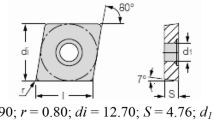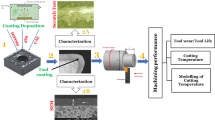Abstract
Duplex stainless steels (DSS) are preferred replacement to austenitic stainless steel because of their higher strength leading to economic benefits. However, poor ductility and thermal conductivity along with high toughness make them difficult to machine. In the present investigation, tool wear, cutting force and surface roughness were evaluated during dry turning of DSS 2205 using tungsten carbide inserts coated with AlTiCrN and AlTiN. High Power Impulse Magnetron Sputtering technique was used for coating the substrates. Cutting speeds of 100, 140 and 180 m/min; feed of 0.12, 0.15, and 0.18 mm/rev, and a fixed depth of cut of 0.8 mm were chosen as cutting parameters for dry turning. AlTiCrN coating exhibited highest adhesion strength of 110 N compared to 89 N by AlTiN coating. AlTiCrN coated tools exhibited highest tool life of 7840 mm, with least surface roughness of 0.72 µm and cutting force of 255 N. This is attributed to its excellent physical properties such as good adhesion, higher oxidation resistance and thermal stability, compared to AlTiN coated tool. AlTiCrN and AlTiN coated tools exhibited respectively 6-times and 4-times more tool life than uncoated tools. Combination of high speed (180 m/min) and low feed (0.12 mm/rev) resulted in least surface finish. Regression model developed from the experimental data showed closer agreement (95%) between predicted and experimental values of surface roughness.









Similar content being viewed by others
References
Chiu, L. H., Su, Y. Y., Chen, F. S., & Chang, H. (2010). Microstructure and properties of active screen plasma nitrided duplex stainless steel. Materials and Manufacturing processes,25(5), 37–41.
Gunn, R. N. (1997). Duplex stainless steels: Microstructures, properties and applications. Cambridge: Wood-head Publishing Limited.
Selvaraj, D. P., & Chandramohan, P. (2010). Influence of cutting speed, feed rate and bulk texture on the surface finish of nitrogen alloyed duplex stainless steels during dry turning. Engineering,2, 453–460.
Senthilkumar, K., Senthilkumar, J. S., & Srinivasan, A. (2013). Reducing surface roughness by optimizing the turning parameters. South African Journal of Industrial Engineering,24, 78–87.
Koyee, R. D., Heisel, U., Eisseler, R., & Schmauder, S. (2015). Modeling and optimization of turning duplex stainless steels. Journal of Manufacturing Processes,3, 36–83.
Królczyk, G., Gajek, M., & Legutko, S. (2013). Effect of the cutting parameters impact on tool life in duplex stainless steel turning process. Tehnicki Vjesnik (Technical News),20(4), 587–592.
Krolczyk, G., Nieslony, P., & Legutko, S. (2014). Microhardness and surface integrity in turning process of duplex stainless steel (DSS) for different cutting conditions. Journal of Materials Engineering and Performance,23, 859–866.
Koyee, R. D., Heisel, U., Schmauder, S., & Eisseler, R. (2014). Experimental investigation and multiobjective optimization of turning duplex stainless steels. International Journal of Manufacturing Engineering,1, 1–13.
Kalss, W., Reiter, A., Derflinger, V., Gey, C., & Endrino, J. L. (2006). Modern coating in high performance cutting applications. International Journal of Refractory Metals and Hard Materials,24(5), 399–404.
Pervaiz, S., Deiab, I., & Darras, B. (2013). Power consumption and tool wear assessment when machining titanium alloys. International journal of precision engineering and manufacturing,14(6), 925–936.
Nomani, J., Pramanik, A., Hilditch, T., & Littlefair, G. (2017). Stagnation zone during the turning of duplex SAF 2205 stainless steels alloy. Materials and Manufacturing Processes,32(13), 1486–1489.
International Molybdenum Association. (2014). Practical guidelines for the fabrication of duplex stainless steels (3rd ed.). London: International Molybdenum Association (IMoA).
Choi, Y. (2019). Effects of cutting speed on surface integrity and fatigue performance of hard machined surfaces. International Journal of Precision Engineering and Manufacturing,20(1), 139–146.
Kulkarni, A. P., & Sargade, V. G. (2015). Characterization and performance of AlTiN, AlTiCrN, TiN/TiAlN PVD coated carbide tools while turning SS304. Materials and Manufacturing Processes,30, 748–755.
Krolczyk, G., Legutko, S., & Gajek, M. (2013). Predicting the surface roughness in the dry machining of duplex stainless steel (DSS). Metallurgia,52(2), 259–262.
Pramanik, A., Basak, A. K., Dixit, A. R., & Chattopadhyaya, S. (2018). Processing of duplex stainless steel by WEDM. Materials and Manufacturing Processes,33(14), 1559–1567.
Li, N., Chen, Y., & Kong, D. (2018). Wear mechanism analysis and its effects on the cutting performance of PCBN inserts during turning of hardened 42CrMo. International Journal of Precision Engineering and Manufacturing,19(9), 1355–1368.
Galanis, N. I., Manolakos, D. E., & Vaxevanidis, N. M. (2008). Comparison between dry and wet machining of stainless steel. In Proceedings 3rd international conference on manufacturing engineering (ICMEN) (pp. 91–98).
Johansson, J. (1999). Ph.D. Thesis. Residual Stresses and Fatigue in a Duplex Stainless Steel. Sweden: Linkoping University.
Krolczyk, G. M., Nieslony, A. P., Maruda, R. W., & Wojciechowski, B. S. (2016). Dry cutting effect in turning of a duplex stainless steel as a key factor in clean production. Journal of Cleaner Production,30, 1–12.
Stanislav, V. (1998). New development in super-hard coating: The super-hard nanocrystalline-amorphous composite. Thin Solid Films,317, 449–454.
Bunshah, R. F. (2002). Handbook of hard coatings. New York: William Andrew Publishing.
Hui-Bo, H., Han, W., Li, H., Li, D., et al. (2014). Effect of deep cryogenic treatment on machinability and wear mechanism of TiAlN coated tools during dry turning. International Journal of Precision Engineering and Manufacturing,15(4), 655–660.
Celik, Y. H., Kilickap, E., & Guney, M. (2017). Investigation of cutting parameters affecting on tool wear and surface roughness in dry turning of Ti–6Al–4V using CVD and PVD coated tools. Journal of the Brazilian Society of Mechanical Sciences and Engineering,39, 2085–2093.
Jose, F., Martinho, R. P., Martins, C., & Gouveia, R. M. (2019). Machining GX2CrNiMoN26-7-4 DSS alloy: Wear analysis of TiAlN and TiCN/Al2O3/TiN coated carbide tools behaviour in rough end milling operations. Coatings,9(6), 392–403.
Chinchanikar, S., & Choudhary, S. K. (2016). Comparative evaluations of nose wear progression and failure modes during hard turning under dry and near-dry cutting conditions. International Journal of Machining and Machinability of Materials,18(5–6), 466–473.
Hui-Bo, H., Li, H., Zhang, X., Yue, Q., et al. (2018). Research on the cutting performances and wear mechanisms of TiAlCrN coated tools during dry turning. International Journal of Precision Engineering and Manufacturing. https://doi.org/10.1007/s12541-019-00026-y.
Strnad, P. C. (2012). Novel coating for high performance cutting and dry machining. In 6th edition of interdisciplinarity in engineering international conference (pp. 75–80).
Li, Y. M., Yue, Q., Li, H. Y., & He, H. B. (2018). Friction and wear characteristics of 20Cr steel substrate and TiAlN coating under different lubrication conditions. International Journal of Precision Engineering and Manufacturing,19(10), 1521–1528.
Diniz, A. E., & Micaroni, R. (2002). Cutting conditions for finish turning process aiming: The use of dry cutting. International Journal of Machine Tools & Manufacture,42, 899–904.
Zaharudin, A., & Budin, S. (2019). Influence of cutting speed on coated TiCN cutting tool during turning of AISI 316L stainless steel in dry turning process. In Proceedings in: 1st international conference on industrial and manufacturing engineering (pp. 1–6).
Kondo, M. Y., Pinheiro, C., Marcelo, A., Souza, T. A., & SouzaKondo, V. C. (2019). Cutting parameters influence investigations on cutting consumed power, surface roughness and tool wear during turning of superalloy VAT 32with PVD coated carbide tools using Taguchi method. Material Research Express,1, 1–16. https://doi.org/10.1088/2053-1591/ab0da8.
Rajaguru, J., & Arunachalam, N. (2017). Coated tool Performance in dry turning of super duplex stainless steel. In Proceedings in: 45th SME North American manufacturing research conference (Vol. 10, pp. 601–611) NAMRC 45, LA, USA.
Selvaraj, D. P., & Chandrasekar, P. (2018). Experimental investigations of nitrogen alloyed duplex stainless steel in dry milling process. Journal of Engineering Science and Technology,13(2), 321–331.
Gutakovskis, V., Bunga, G., & Torims, T. (2010). Stainless steel machining with nanocoated duratomic TM cutting tools. In Proceedings in: 7th international DAAAM baltic conference industrial engineering (pp. 1–6) Tallinn, Estonia.
Selvaraj, D. P., Chandramohanb, P., & Mohanraj, M. (2014). Optimization of surface roughness, cutting force and tool wear of nitrogen alloyed duplex stainless steel in a dry turning process using Taguchi method. Measurement,49, 205–215.
Honess, C. (2006). Importance of surface finish in the design of stainless steel. Rotherham: Swinden Technology Centre.
Abhang, L. B., & Hameedullah, M. (2018). Modeling and analysis of tool wear based on cutting force and chip-tool interface temperatures in turning. Advanced Manufacturing and Materials Science,1, 411–420.
Kumar, P. (2019). A surface roughness predictive model for DSS longitudinal turning operation, chapter 25 (pp. 285–296). Vienna: Daaam International Scientific Book.
Zhang, H. P., Zhang, Q. Y., Ren, Y., Shay, T., & Liu, G. L. (2018). Simulation and experiments on cutting forces and cutting temperature in high speed milling of 300M steel under CMQL and dry conditions. International Journal of Precision Engineering and Manufacturing,19(8), 1245–1251.
Chen, Y., Sun, Y., Lin, H., Zhang, B. (2018) Prediction model of milling surface roughness based on regression analysis (Vol. 83, pp. 557–560).
Jebaraj, A. V., Ajaykumar, L., & Deepak, C. R. (2017). Weldability, machinability, and surfacing of commercial duplex stainless steel AISI 2205 for marine application. Journal of Advanced Research,8, 183–199.
Kim, D. H., Zhang, T. F., Shin, J. H., Kang, M. C., & Kim, K. H. (2016). Microstructure and mechanical properties of Cr–Ni–N coatings deposited by HiPIMS. Surface Engineering,32(4), 314–320.
Sonawane, G., & Sargade, V. (2019). Studies on the characterization and machinability of duplex stainless steel 2205 during dry turning. International Journal of Mechanical and Industrial Engineering,13(5), 349–353.
Organization, I. S. (1993). Tool Life testing with single point turning tools. ISO 3685 2(11), 1–48.
Shanmugarajan, B., & Shrivastava, S. B. (2016). Optimisation of laser welding parameters for welding of P92 material using Taguchi based grey relational analysis. Defence Technology,12(4), 343–350.
Abhang, L. B., & Hameedullah, M. (2010). Chip-tool interface temperature prediction model for turning process. International Journal of Engineering Science and Technology,2(4), 382–393.
Altun, O., & Boke, Y. E. (2009). Effect of microstructure of EB-PVD thermal barrier coatings on thermal conductivity and methods to reduce thermal conductivity. Archives of Materials Science and Engineering,40(1), 47–52.
Veprek, S. (1998). New development in superhard coatings: The superhard nanocrystalline-amorphous composites. Thin Solid Films,317(1–2), 449–454.
Kulkarni, A. P., Joshi, G. G., & Sargade, V. G. (2013). Performance of PVD AlTiCrN coating during machining of austenitic stainless steel. Surface Engineering,29(5), 402–407.
Saï, W. B., & Lebrun, J. L. (2003). Influence of finishing by burnishing on surface characteristics. Journal of Material Engineering and Performance,12(1), 37–40.
Bouchnak, T. B., & Germain, G. (2010). High pressure water jet assisted machining of duplex SS: Machinability and tool life. International Journal of Material Forming,3(1), 507–510.
Acknowledgements
The authors would like to express gratitude to CemeCon, Germany for providing timely support for tool coating.
Funding
The authors would like to thank the NEB and Department of Science and Technology (DST), Govt. of India for funding this project (Ref: 11/10/2015-NEB (G)/03 Dated 27/09/2017).
Author information
Authors and Affiliations
Corresponding author
Ethics declarations
Conflict of interest
The authors declare that there is no conflict of interest and authors have full control of all the data included in manuscript and authors are agree to allow journal to review their data, if required.
Ethical Standards
The manuscript does not contain any clinical studies or patient data.
Additional information
Publisher's Note
Springer Nature remains neutral with regard to jurisdictional claims in published maps and institutional affiliations.
Rights and permissions
About this article
Cite this article
Sonawane, G.D., Sargade, V.G. Machinability Study of Duplex Stainless Steel 2205 During Dry Turning. Int. J. Precis. Eng. Manuf. 21, 969–981 (2020). https://doi.org/10.1007/s12541-019-00305-8
Received:
Revised:
Accepted:
Published:
Issue Date:
DOI: https://doi.org/10.1007/s12541-019-00305-8




